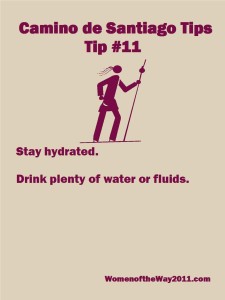 You can suffer from dehydration on the Camino any time of the year, but especially in warm weather and in the Meseta. Drink plenty of water or fluids as dehydration leads to all sorts of problems. Since thirst isn’t always a reliable gauge of the body’s need for water, drink even if you are not thirsty. A better dehydration gauge is the color of your urine: clear or light-colored urine means you’re well hydrated, whereas a dark yellow or amber color usually signals dehydration.
You can suffer from dehydration on the Camino any time of the year, but especially in warm weather and in the Meseta. Drink plenty of water or fluids as dehydration leads to all sorts of problems. Since thirst isn’t always a reliable gauge of the body’s need for water, drink even if you are not thirsty. A better dehydration gauge is the color of your urine: clear or light-colored urine means you’re well hydrated, whereas a dark yellow or amber color usually signals dehydration.
Dehydration occurs in hikers when the body has lost too much fluid and electrolytes (both potassium and sodium) which can be accelerated by strenuous activity, altitude, illness, medications, diarrhea and warm weather. Although proper hydration is one of the keys is keeping from becoming dehydrated, you also need to have the correct balance of electrolytes as well. To increase the electrolytes, eat foods with sodium, drink fruit juices, and eat soft fruits such as bananas and vegetables with potassium.
Sports drinks such as Gatorade are available in some of the larger supermercados, but the more common sports drink sold in Spain is Aquarius, manufactured by The Coca-Cola Company. In Spain, this beverage is available in the following flavors: Aquarius (Lemon flavored), Aquarius Naranja (Orange flavored), and Aquarius Libre (0% Sugar/Sugarless).
Some scientists say a pint of beer is better for you after a workout than water. The Spanish cerveza is tasty and available everywhere. Note: drinking too much alcohol can leave you dehydrated, so always drink in moderation.
Symptoms of dehydration:
- Dry, sticky mouth
- Sleepiness or tiredness
- Thirst
- Decreased urine output — eight hours or more without urination
- Few or no tears when crying
- Dry skin
- Headache
- Constipation
- Dizziness or lightheadedness
Dehydration, if left untreated, can be extremely dangerous. Get medical attention if the symptoms become severe.
Symptoms of severe dehydration, a medical emergency
- Extreme thirst
- Extreme fussiness, irritability, and confusion
- Very dry mouth, skin and mucous membranes
- Lack of sweating
- Little or no urination — any urine produced is dark yellow or amber
- Sunken eyes
- Shriveled and dry skin that lacks elasticity and doesn’t “bounce back” when pinched into a fold
- Low blood pressure
- Rapid heartbeat
- Rapid breathing
- No tears when crying
- Fever
- In the most serious cases, delirium or unconsciousness
How much should you drink
So, how much should you drink to prevent dehydration while walking on the Camino? Though the amount of fluid intake depends on the individual, use the following guidelines as a starting point, and modify your fluid needs accordingly. In the morning, drink a half liter of fluids 10-15 min before starting to walk. A glass of orange juice (zumo de naranja) and a café con leche is a great way to start the day. Drink a half liter every kilometer. Continue to hydrate after stopping for the day.
Do not drink too much water, which may cause hyponatremia, aka water intoxication. Drinking excessive amounts of plain water can cause a low concentration of sodium in the blood.
To prevent this, drink a sodium-containing sports drink or eat salty foods. Nuts and olives are available in most stores along the Camino.
Is the fountain water safe on the Camino?
I found the water in the fountains safe to drink unless it was marked no potable. Most towns sell bottled water, so you may want to purchase this if you are hesitant to drink fountain water. Read more about what others have to say on the Camino de Santiago forum on drinking water.
Two drinks I enjoyed on the Camino de Santiago were manzanilla (chamomile tea) and Fanta limon, a lemon soda.
What drink did you enjoy the most on the Camino? Please leave a comment.
Buen Camino
Jane V. Blanchard